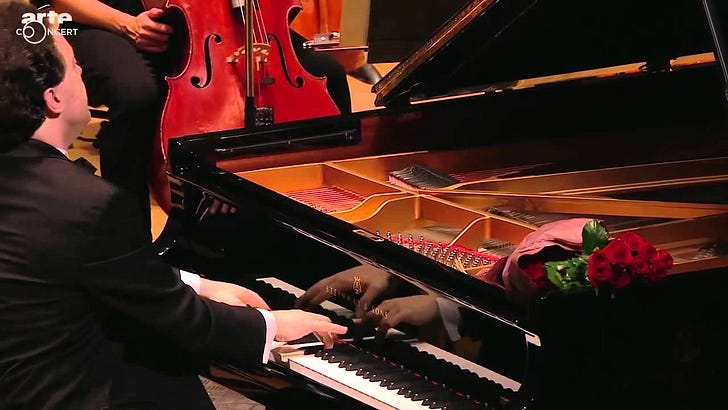I was texting with my sister the other other night. Despite being the furthest apart in age (she’s the eldest of the five of us, I’m the youngest), we’re the most similar in many respects. We updated each other on the local wildlife. Where she is, it seems like the deer are getting bolder and getting up to some proper hooligan shit. I told her about the robins that have some kind of conspiratorial congress on my back patio every morning.
She also mentioned that she’s learning a Rachmaninoff piece, his “Prelude in C# Minor”, and sent me this performance of it by Evgeny Kissin.
One way in which she and I are very different is in our dedication to making music. My family were all musically inclined, except for my father. Dad used to joke that the only instrument he played was the radio, but he’d gotten pretty good at it. My sister is the only one that’s stuck with it and still plays regularly. These days my own instruments are closer to household totems than they are actual instruments. Maybe some day, I tell myself as I have almost every day since I gave up my scholarship.
I listened to this Kissin rendition of the “Prelude” several times the past few days. I’m captivated by its structure. It’s a shockingly simple piece and its ABA form feels almost underwhelming. It’s simpler than most modern pop songs, but it derives a surprising amount of strength from that simplicity. It manages to set tonal and melodic themes, develop them, and resolve them all in a remarkably dense package.
As the first prelude in the larger project that Rachmaninoff would eventually undertake (his 24 preludes covering the major and minor keys, following in the steps Chopin about sixty years earlier) it also feels like a bolder statement of purpose. It seems like a character study of the feel of the key itself, and that it’s setting up a series of portraits. It’s also an odd place to start. It’s a half step off from where one would normally start a circle of fifths. Its somber, almost morose tone feels like an odd vibe to start such a study with. The simple structure feels self-contained. It possesses a sense of finitude that seems to preclude it being used as part of a larger cycle.
It’s interesting to compare it to the “Prelude in G major”, which feels so much less structured and certain. It’s ethereal and seems like a formless, gossamer fabric that arises from nowhere, blows about, and ends nowhere. It’s somehow just as affecting, though.
I think listening to the preludes this past week has, regrettably, convinced me that my theory teacher in university was right: there is an inescapable and inherent character to every key and mode. Now, twenty years on, I can’t even remember why I was so resistant to the idea, but I was sure that only their relations to one another and the way you moved between them mattered. Maybe it’s because I was a jazz dork whose only hope from theory was to solo a little better. Maybe it’s because I sort of resented that I had to take a theory class to keep my (modest) scholarship. Maybe it’s because I was (and am) extremely lazy and didn’t really want to learn to play well in all the various rare keys and modes we had to examine in depth.
Whatever it was, I was sure that it didn't really matter what the key was as long as you progressed through the chords in the right intervals.
I was, and continue to be, a poor musician. I had a small amount of technical talent and a huge enthusiasm for the music of others, but I lacked the requisite passion to make it for myself. It’s why I no longer own a horn and am staring at a bass guitar I haven't touched in almost a year. I admire that my sister is teaching herself Rachmaninoff pieces that will likely only be heard by the hummingbirds that swarm the feeders outside her window.




Enjoying your music analysis.